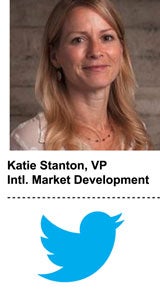 Twitter significantly boosted its advertising profile last week, acquiring mobile ad exchange MoPub and filing (confidentially) for an IPO.
Twitter significantly boosted its advertising profile last week, acquiring mobile ad exchange MoPub and filing (confidentially) for an IPO.
The San Francisco-based company is expected to bring in $583 million in advertising revenue this year, and $950 million in 2014, according to eMarketer. It also earns additional revenue by selling the data in its “fire hose” or raw feed of hundreds of millions of messages daily.
But Katie Stanton, Twitter’s VP of international market development, said very little about the company’s ad products as she delivered the closing keynote to thousands of advertisers at the Dmexco conference in Germany. Instead, she focused on the way people use Twitter and what brands can learn from that.
What makes the platform successful, Stanton said, is that it is “a social broadcast network that enables all of us to be in the moment.”
“Twitter is a real-time platform that helps people extend experiences and enables you to connect to anyone, anywhere,” Stanton said. She listed several usage stats: Of the more than 200 million people who use Twitter, 60% access it through a mobile device. Approximately 40 million people are using Vine, and more than 3 billion tweets are created in one week.
In terms of turning conversations on Twitter into branding opportunities, Stanton pointed to Nik Wallenda, an American acrobat and high-wire artist who crossed the Grand Canyon on a tightrope.
Wallenda documented his stunt on YouTube and included a snippet of it on Vine with the hashtag #skywire. Wallenda received more than 1 million tweets about the video with many users commenting on his decision to wear boot-cut jeans that were flapping in the wind. Even though he wasn’t wearing its jeans, brands like Lee’s quickly latched on to the conversation with the tweet, “Denim: preferred by cowboys, rockstars and @NikWallenda #skywire.”
Stanton also used examples of sports and music events where people turned to Twitter to share information about it and brands chimed in.
“It’s important for brands to be ready for those big moments,” Stanton noted. “You don’t know what the big play will be, but you do know that everyone’s watching and you have to be there.”











